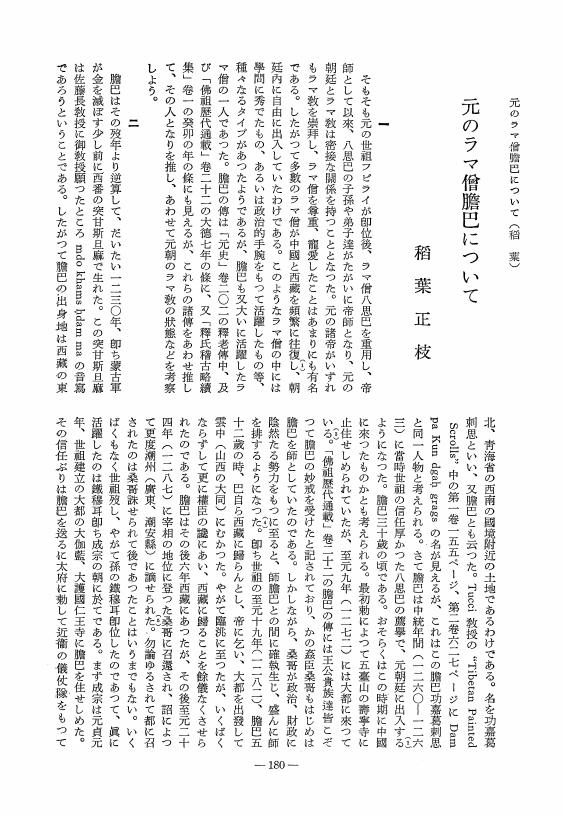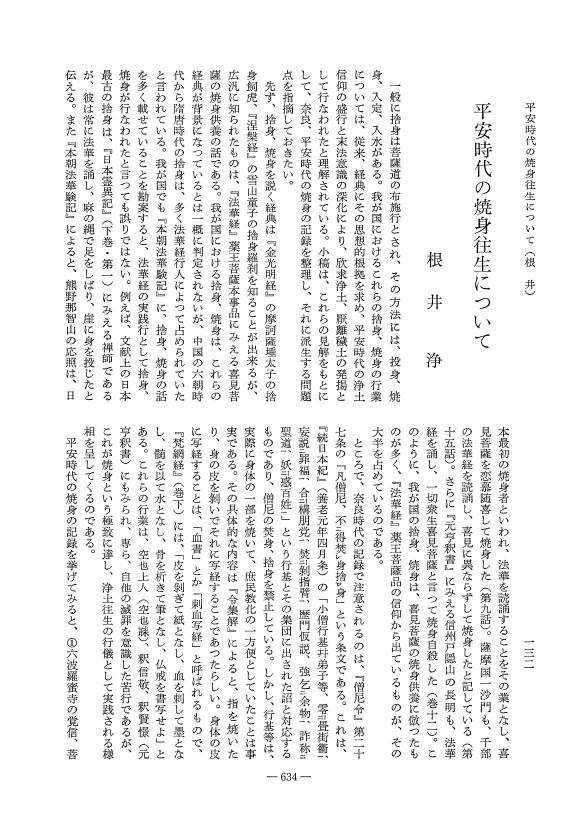15 0 0 0 平安時代の女性の写経と結縁経――『久能寺経』研究の一環として――
- 著者
- 山口 希世美
- 出版者
- 日本印度学仏教学会
- 雑誌
- 印度學佛教學研究 (ISSN:00194344)
- 巻号頁・発行日
- vol.66, no.2, pp.713-716, 2018
<p>In this paper, by analyzing diaries from the Heian period, I shed light on the fact that handwritten <i>sūtra</i> transcription by women were not rare.</p><p>The <i>Kechiengyō</i> is one example of women's handwriting. One type of currently existing <i>Kechiengyō</i> is called <i>Kunōji-kyō</i>. <i>Kunōji-kyō</i> is a common name of the <i>Lotus Sūtra</i> introduced to Kunōji temple. Among the existing 25 scrolls, women's names are written on 15.</p><p>Considering these cases, the possibility that <i>Kunōji-kyō</i> was indeed handwritten by women cannot be excluded.</p>
14 0 0 0 OA 元のラマ僧膽巴について
- 著者
- 稻葉 正枝
- 出版者
- JAPANESE ASSOCIATION OF INDIAN AND BUDDHIST STUDIES
- 雑誌
- 印度學佛教學研究 (ISSN:00194344)
- 巻号頁・発行日
- vol.11, no.1, pp.180-182, 1963-01-15 (Released:2011-06-08)
11 0 0 0 OA 宝唱『名僧伝』に見られる「師」・「苦節」の区別について
- 著者
- 李 尚曄
- 出版者
- 日本印度学仏教学会
- 雑誌
- 印度學佛教學研究 (ISSN:00194344)
- 巻号頁・発行日
- vol.69, no.2, pp.789-786, 2021-03-25 (Released:2021-09-06)
- 参考文献数
- 4
By utilizing previous studies that have identified the biographies of the monks included in the now-lost Mingseng zhuan 名僧伝 from the Gaoseng zhuan 高僧伝, this paper analyzes the uneven distribution of social traits among the monks who were categorized as “shi” 師 and “kujie” 苦節 in the Mingseng zhuan, and proposes the possibility that Baochang’s use of the dual categories of “shi” and “kujie” in the Mingseng zhuan reflected the dualistic class structure of the early medieval Chinese saṃgha.
11 0 0 0 OA 僧と陰陽師
- 著者
- 木場 明志
- 出版者
- Japanese Association of Indian and Buddhist Studies
- 雑誌
- 印度學佛教學研究 (ISSN:00194344)
- 巻号頁・発行日
- vol.26, no.2, pp.757-760, 1978-03-20 (Released:2010-03-09)
11 0 0 0 OA 唐初期三一権実論争の起因に対する論争当事者の認識
- 著者
- 小野嶋 祥雄
- 出版者
- 日本印度学仏教学会
- 雑誌
- 印度學佛教學研究 (ISSN:18840051)
- 巻号頁・発行日
- vol.63, no.2, pp.752-756, 2015-03-20
11 0 0 0 唐初期三一権実論争の起因に対する論争当事者の認識
- 著者
- 小野嶋 祥雄
- 出版者
- 日本印度学仏教学会
- 雑誌
- 印度學佛教學研究 (ISSN:00194344)
- 巻号頁・発行日
- vol.63, no.2, pp.752-756, 2015
- 著者
- 堀 伸一郎
- 出版者
- 日本印度学仏教学会
- 雑誌
- 印度學佛教學研究 (ISSN:18840051)
- 巻号頁・発行日
- vol.63, no.3, pp.1322-1328, 2015-03-25
識語に15世紀の日付を明記する古ベンガル文字仏教写本が複数存在する.本稿では,ケンブリッジ大学図書館所蔵Kalacakratantra貝葉写本(Add. 1364)の識語について,実見調査に基づく解読結果を提示した上で日付・地名・人名・肩書等を検討する.同写本は1870年代に外科医Daniel Wrightがカトマンドゥ盆地で収集したものである.Kalacakratantra校訂本(Raghu Vira and Lokesh Chandra 1966およびBanerjee 1985)では本写本が使用された.2枚の夾板の両面に細密画が描かれているため,Pratapaditya Palをはじめ多くの美術史研究者の注目を集めた.従来の研究では写本の年代を1446年とするが,識語の日付に曜日が含まれているため,インドの暦法に基づいて日付を西暦に換算し確定することが可能である.「ヴィクラマ暦1503年Bhadrapada月黒分13日水曜日」という日付が,満年数・Karttika月始まり・満月終わりで記述されているものとすれば,Suryasiddhantaに基づくソフトウェアpancangaによって,西暦1447年8月9日水曜日に確定する.寄進者は,sakyabhiksuの肩書を持つJnanasriである.筆写者はJayaramadattaであり,sasanikakaranakayastha(行政書士)という肩書を持っていた.筆写者の居住地と考えられるKerakiという村名は,データベースIndia Place Finderで検索すると,ビハール州ガヤー県Kerki村,ジャールカンド州パラームー県Kerki村という二つの比定候補が見出される.識語の最後に書かれる1詩節は,Ratnavadanatattvaの最終詩節と一致する.Kalacakratantra写本の他,コルカタ・アジア協会所蔵Bodhicaryavatara写本(G. 8067)の識語に記される日付は,西暦1436年2月21日火曜日に確定し,ムンバイ・個人所蔵Karandavyuha写本の日付は,西暦1456年10月27日水曜日に確定する.東インドでは,ヴィクラマシーラ等の大規模仏教寺院が13世紀初頭までにテュルク系ムスリム軍の軍事攻撃で破壊された後,仏教が滅亡したというのが従来の通説であった.しかし本稿で扱う写本識語は,15世紀中葉の東インド村落地域にサンスクリット仏教文献を伝承する仏教徒が存在したことを明確に示しており,通説に再考を促すものとなろう.
10 0 0 0 色(rupa)は物質ではない:――仏典における原意と訳語の考察――
- 著者
- 村上 真完
- 出版者
- 日本印度学仏教学会
- 雑誌
- 印度學佛教學研究 (ISSN:00194344)
- 巻号頁・発行日
- vol.59, no.2, pp.858-851, 2011
9 0 0 0 OA 平安時代の焼身往生について
- 著者
- 根井 浄
- 出版者
- Japanese Association of Indian and Buddhist Studies
- 雑誌
- 印度學佛教學研究 (ISSN:00194344)
- 巻号頁・発行日
- vol.27, no.2, pp.634-635, 1979-03-31 (Released:2010-03-09)
9 0 0 0 OA 善導の在家弟子に見る臨終行儀――新出「念弥陀仏誦弥陀経行者」墓誌銘について――
- 著者
- 倉本 尚徳
- 出版者
- 日本印度学仏教学会
- 雑誌
- 印度學佛教學研究 (ISSN:00194344)
- 巻号頁・発行日
- vol.70, no.1, pp.67-73, 2021-12-20 (Released:2022-09-09)
- 参考文献数
- 7
This paper presents the original text and a modern Japanese translation of an epitaph for the Tang period lay person Bao Baoshou 包宝寿, and then examines connections between Shandaoʼs 善導 writings and the epitaphʼs portrayal of daily life practices for Pure Land rebirth and deathbed rites. The former consist of being mindful of Amitābha Buddha, reciting the Amituo jing, and maintaining the abstinential rules. The daily life practices for rebirth and the signs of the coming of the holy retinue to welcome him to the Pure Land experienced by Bao at the end of his life can be seen as the “highest of the high stage” (shangpin shangsheng 上品上生) as described in the Pure Land Contemplation Sūtra 観無量寿経, and also match the practice for the “highest of the high stage” in the Guannian famen 観念法門. Many lay practitioners were present at the end of Baoʼs life and Shandao also emphasized the existence of fellow practitioners.
- 著者
- 下田 正弘
- 出版者
- 日本印度学仏教学会
- 雑誌
- 印度學佛教學研究 (ISSN:00194344)
- 巻号頁・発行日
- vol.68, no.2, pp.1043-1035, 2020-03-20 (Released:2020-09-10)
- 参考文献数
- 19
More than fifteen years ago, Schopen (2004, 492) revealed his concern about a certain understanding widespread among scholars of the history of Indian Buddhism, writing, “[t]he historical development of Indian Buddhism used to be presented as simple, straightforward, and suspiciously linear. It started with the historical Buddha whose teaching was organized, transmitted, and more or less developed into what was referred to as early Buddhism. This Early Buddhism was identified as Hīnayāna ... , Theravāda ... , or simply ‘monastic Buddhism.’ ... A little before or a little after the beginning of the common era this early Buddhism was, according to the model, followed by the Mahāyāna ... ” A similar apprehension has recently been expressed in slightly different terms by Harrison (2018, 8–9). It is certainly surprising that scholars’ basic frame of reference for the history of Indian Buddhism is more or less what it was in the late 19th century, despite all of the progress recently made in this field. Developments in the particulars of the subfields of Indian Buddhist history have not entailed comparable developments in the broader frame of reference, despite the fact that such a frame is what allows us to identify and synthesize the details of our field. This paper attempts to address this problem by focusing on three points: first, it reexamines the current state of affairs of materials for the reconstruction of the history of ancient India; second, it reevaluates the status of Pāli materials as historical sources; and third, it reconsiders the concept of ‘canon’ in Buddhist studies.
9 0 0 0 OA 日本梵字弥陀名号の研究
- 著者
- 斎藤 彦松
- 出版者
- Japanese Association of Indian and Buddhist Studies
- 雑誌
- 印度學佛教學研究 (ISSN:00194344)
- 巻号頁・発行日
- vol.36, no.1, pp.260-263, 1987-12-25 (Released:2010-03-09)
9 0 0 0 OA 梵字勃〓〓 Bhrum 信仰の研究
- 著者
- 齋藤 彦松
- 出版者
- Japanese Association of Indian and Buddhist Studies
- 雑誌
- 印度學佛教學研究 (ISSN:00194344)
- 巻号頁・発行日
- vol.28, no.2, pp.837-840, 1980-03-31 (Released:2010-03-09)
9 0 0 0 OA 震災と仏教(仏教学は何をめざすのか,第63回学術大会パネル発表報告)
- 著者
- 師 茂樹
- 出版者
- 日本印度学仏教学会
- 雑誌
- 印度學佛教學研究 (ISSN:18840051)
- 巻号頁・発行日
- vol.61, no.2, pp.795-794, 2013-03-20
8 0 0 0 OA 下田正弘とグレゴリー・ショペン : 大乗仏教の起源をめぐって
- 著者
- 佐々木 閑
- 出版者
- 日本印度学仏教学会
- 雑誌
- 印度學佛教學研究 (ISSN:00194344)
- 巻号頁・発行日
- vol.61, no.1, pp.342-334, 2012-12-20
7 0 0 0 OA 釈道安の長安移住年次の再考――「比丘大戒序」等に見える木星紀年法の分析を通して――
- 著者
- 李 尚曄
- 出版者
- 日本印度学仏教学会
- 雑誌
- 印度學佛教學研究 (ISSN:00194344)
- 巻号頁・発行日
- vol.71, no.2, pp.750-746, 2023-03-22 (Released:2023-09-08)
- 参考文献数
- 13
Dao’an’s 道安 (314-385 CE) relocation to Chang’an is an important historical event that marked the revival of translation activities among Buddhists in early medieval China. Earlier scholars such as Tang Yongtong, Erik Zürcher, and Ui Hakuju assumed that Dao’an’s relocation to Chang’an took place in the year 379. However, this hypothesis does not take into account the Jovian years recorded in the documents produced by Dao’an’s translation team in Chang’an. In this paper, by making use of such resources as the astronomy simulation software Stellarium, I show that the Jovian years recorded in the Dao’an team’s documents match the actual locations of Jupiter of the time, and argue that Dao’an’s relocation to Chang’an must have taken place in 378 rather than in 379.
7 0 0 0 OA インド密教における護摩儀礼の展開
- 著者
- 森 雅秀
- 出版者
- Japanese Association of Indian and Buddhist Studies
- 雑誌
- 印度學佛教學研究 (ISSN:00194344)
- 巻号頁・発行日
- vol.42, no.1, pp.420-412, 1993-12-25 (Released:2010-03-09)
- 参考文献数
- 18
- 被引用文献数
- 1
7 0 0 0 OA 『大目乾連冥間救母変文』における救済方法の考察
- 著者
- 筑後 誠邦
- 出版者
- 日本印度学仏教学会
- 雑誌
- 印度學佛教學研究 (ISSN:00194344)
- 巻号頁・発行日
- vol.57, no.1, pp.99-102, 2008-12-20 (Released:2017-09-01)
7 0 0 0 OA 日本で発見されたオリヤー語の『マハーバーラタ』について
- 著者
- Shobha Rani DASH
- 出版者
- Japanese Association of Indian and Buddhist Studies
- 雑誌
- 印度學佛教學研究 (ISSN:00194344)
- 巻号頁・発行日
- vol.54, no.2, pp.872-869,1324, 2006-03-20 (Released:2010-07-01)
A palm leaf manuscript of the Oriya Mahabharata written by the famous Oriya poet Sudramuni Srisaraladasa of the mid 15th c. was transmitted to Tsusima-cho of Ehime prefecture in Japan during the 18th century A. D. It ia ssumed that the manuscript was transcribed in the beginning of the 17th c. It was written in the medieval Oriya language using the medieval Oriya script except the invocation to Lord Ganesa, which is in Sanskrit. It consists of 221 leaves (transcribed on both sides), a few blank leaves and a bamboo cover. In the beginning and the end of the manuscript it mentions clearly that it is the first part of the Aranyakaparba of the Mahabharata. It is a typical manuscript of Orissa, an Eastern state in India. The most interesting point to note is that it is not just an Oriya translation of the Sanskrit Mahabharata, but is an Oriya version of it. Since 2001, I have been working on its romanized edition and Japanese translation along with Mr. Nobuyuki Kashiwahara and Prof. Hojun Nagasaki as the chief. A new relationship between Orissa and Japan is expected to be explored from the research of this manuscript.
7 0 0 0 如来蔵思想は仏教にあらず
- 著者
- 松本 史朗
- 出版者
- 日本印度学仏教学会
- 雑誌
- 印度學佛教學研究 (ISSN:00194344)
- 巻号頁・発行日
- vol.35, no.1, pp.375-370, 1986










